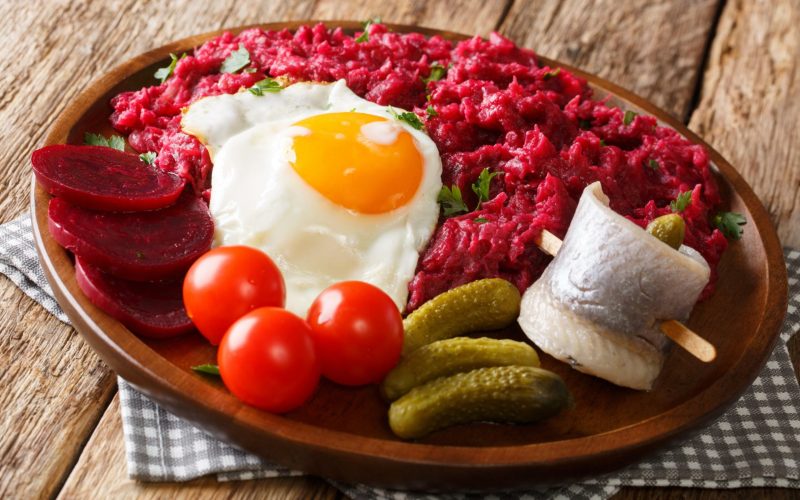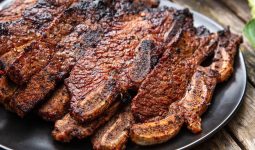Traditional German foods are filling and incredibly tasty, varying significantly throughout the year.
Mushrooms, games, and vegetables all have a particular season. Many Germans prepare their meals using local and fresh ingredients, which is their secret.
Germany is famous for its bread and sausages, which frequently substitute meat in regular meals.
Weisswurst is a traditional Bavarian food sold at butcher shops across Germany these days.
It’s uncommon to find a restaurant outside of Bavaria that offers Weisswurst. Currywurst originated in Berlin and is now a popular snack in Germany.
In Baden-Württemberg, the most popular dishes are spätzle, maultaschen, and black forest cake. Seafood abounds in the northern states.
However, well-known beef dishes such as königsberger klopse and grünkohl, mitpinkel, corned beef, beets, potatoes, and herring make up labskaus.
Soups are a big part of German cuisine. Germans adore soup, whether light soups as an appetizer or substantial soups and stew as a main course.
Here is a list of delicious and mouth-watering traditional German foods you should try.
Traditional German Foods
1. Rumkuchen
Rumkuchen is a great post-meal treat that will give you maximum satisfaction. It is a cold-weather rum cake that comes out when the weather gets cold.
Rumkuchen is a solid cake that is served with cherries. German pastries with cherries included are divine!
2. German Pretzels
German Pretzels are Germany’s most popular export. They are salty knots tossed by German bakers most lovingly.
“Bretzels,” as the Germans love to call them, are loved generally and pair well with beer.
What’s more? These pretzels can be found anywhere in the country, and they’re worth trying out as they taste differently. In Bavaria, they are usually served with butter, spicy mustard, and white sausage.
3. Currywurst
If you haven’t tried currywurst, especially those sold at street corners, you’re missing out on a lot.
They are usually cooked in ketchup and curry powder and served hot. Currywurst is a spicy and filling dish with fries. It is a students’ favorite in Hamburg, Berlin, and other German university towns.
4. Döner Kebab
Döner Kebab is a traditional German food inspired by Turkish culture. It is very popular in Germany because there are more kebab stands in Berlin than in Istanbul.
The Döner Kebab consists of meat sliced vertically, wrapped in a pita, and covered in onions, lettuce, tomatoes, and a garlic yogurt sauce.
This Kebab is a go-to late-night food choice, and there’s no wrong time to have one.
5. Weichnachtsgans
Weichnachtsgan is a traditional German food usually made during Christmas. It is a roasted goose with onions, apples, prunes, chestnuts, and/or dates.
The goose is generally packed with a dough or meat filling and seasoned with salt, thyme, pepper, and, in most cases, marjoram.
Weichnachtsgan often gets served with simple staples like red cabbage, dumplings, spätzle, and gravy.
There is a general belief that this food originates from an ancient Catholic custom. A goose gets prepared on St. Martin’s Day (November 11th).
At the end of the fasting period, another goose called Weichnachtsgan is prepared to celebrate on the eve of Christmas.
6. Grünkohl
Grünkohl, meaning kale, is another traditional German food that refers to different German dishes with kale as their main ingredient.
This vegetable is commonly used during the country’s traditional fall and winter specialties.
Plus, it is usually blanched in hot water before it gets cooked alongside other ingredients.
Whether you have fresh or frozen kale, it doesn’t matter, as both can suffice, although there’s the belief that frozen kale releases a sweeter flavor than fresh one. You can serve Grünkohl with dumplings, potatoes, and beer.
7. Hackepeter
Hackepeter, or mett, is an unusual traditional German food of raw pork mince consumed in its fresh and raw form.
You’ll season the raw meat with pepper and salt. For extra flavor, you can improve it with marjoram, onions, nutmeg, crushed caraway, and garlic.
The addition of raw onions to the basic mett results in zwiebelmett, and the addition of onions and marjoram results in what is called thüringer mett.
However, in Germany, seasoned raw pork mince can be enjoyed spread over slices of bread or bread rolls (mettbrötchen) with raw onion rings sprinkled on top.
8. Dampfnudeln
This is a traditional German food made using water, milk, and butter to cook yeast dough dumplings.
When the liquids evaporate, the dumplings are fried in butter until they create a crispy crust at the bottom.
At the same time, the top still stays soft from the cooking process. Dampfnudeln can be prepared sweet or savory, depending on the individual’s taste buds. The savory version is cooked in salt water.
Usually, it doesn’t have a filling; you can serve it with a thick potato soup. The sweet one gets filled with fruit jam and served with vanilla custard or dessert.
9. Grießbrei
This is another traditional German pudding. It is made with semolina, milk, and sugar, sometimes with vanilla and cinnamon added for extra flavor.
To make Grießbrei, heat the milk, add the semolina, and stir until it gets thick and creamy.
Many people enjoy having semolina pudding for breakfast. They can take the dish to another level by adding apples, cherries, pears, and strawberries.
In conclusion, serving this dish in a shallow bowl is highly recommended as it allows enough room for the toppings.
10. Pellkartoffeln
Pellkartoffeln is boiled or steamed potatoes with their skin intact. This traditional German food can be eaten alone or served alongside other dishes.
The potatoes are scrubbed thoroughly to remove dirt and then steamed in water seasoned with salt and, at times, bay leaves or caraway seeds.
Allowing the potatoes to cook with the skin intact is one way to retain more natural flavor and nutrients; it also cook better this way.
After steaming, the potatoes can be peeled or consumed with their skin. The easiest way to enjoy pellkartoffeln is with salt and butter. However, some people like it with kräuterquark (quark mixed with fresh herbs).
11. Nudelsuppe
Nudelsuppe is another traditional German food (noodle soup) made of noodles in clear soup.
This soup is traditionally made up of a rich beef or chicken broth with German vegetables or greens(Suppengrün) such as celery, carrots, turnips, leeks, onions, and parsnips.
The most used noodles for this soup are the thin egg noodles (faddennudeln), although other variants can be used.
In making this dish, the noodles and soup are cooked separately. The boiled noodles are then transferred into the hot soup before serving.
12. Fischbrötchen
This is a sandwich popularly eaten in Northern Germany. It is made with fish and other ingredients such as horseradish, pickles, lettuce, remoulade, and onions.
These ingredients are placed in round and stretched bread buns. The fish used in the preparation of this sandwich can vary.
Some popular fish include salmon, herring, mackerel, and sprat. Fischbrötchen is usually served at fast-food stands in Germany.
13. Sauerkraut
This is a typical traditional German food made from cutting cabbage into tiny strips and Lacto-fermented in brine, which gives it an acidic flavor (hence its name in German: Kraut, which means cabbage, and Sauer, which means acid).
Sauerkraut is frequently served alongside sausages or schupfnudeln, a type of elongated gnocchi popular in southern Germany and Austria.
14. Spaghettieis
Spaghettieis is an ice cream dish made from a plate of spaghetti. This traditional German food was invented in 1969 by Dario Fontanella, the son of an ice cream-making Italian immigrant in Mannheim, Germany.
Vanilla ice cream is pressed using a modified noodle press, which gives it a spaghetti look.
It is then placed over whipped cream and topped with strawberry sauce as the tomato sauce.
In addition to using strawberry sauce, you can try other variants, such as dark chocolate ice cream and nuts.
15. Maultaschen
This is a popular specialty in Southern Germany. Maultaschen is a traditional dish that combines minced meat, onions, bread crumbs, and spinach, seasoned with pepper, salt, and parsley.
It is then steamed and served with broth in place of sauce for a tender, creamier treat.
Maultaschen can be found anywhere in Germany but is most common in the south. They are sometimes pan-fried and buttered for extra flavor.
It runs from being savory to sweet and meaty to vegetarian. As of 2009, the European Union recognized this dish as a regional specialty and a part of the cultural heritage of Baden-Württemberg.
16. Rouladen
Rouladen is a delicious combination of bacon, pickles, mustard, and onions wrapped in sliced beef or veal.
Although vegetarian and other meat options are available, rinderrouladen (beef rouladen) is the real deal.
This traditional dish is a staple of special occasions and family dinners. Rouladen is often served with pickled red cabbage, potato dumplings, and mashed potatoes.
To round off this dish, you’ll need a red wine gravy.
17. Labskaus
Labskaus is a delicious dish. Although not the most physically appealing, it represents the seafaring traditions of Northern Germany.
During the 18th and 19th centuries, ships were provided with preserved fare, and the pink slop of labskaus was a delicious way of making them.
This traditional dish has been the favorite of Baltic and the North Sea sailors. The porridge is made from mashed potatoes, salted beef, pickled beetroot, and onions and served with pickled gherkins and rollmops.
Nowadays, this food is very popular all over northern Germany, especially in Hamburg, Bremen, and Kiel. It is also considered a cure for a hangover.
18. Sauerbraten
Sauerbraten (sour roast) is considered one of the traditional German foods. It is traditionally made with horse meat, but beef and venison can be substituted.
Although this dish takes time to make, it is truly worth the work. It’s usually served as a Sunday family dinner.
Before the cooking proper, the meat is marinated for a couple of days in a mixture of red wine, vinegar, herbs, and spices.
It can also be placed in a dark gravy made with beetroot sugar sauce and rye bread to balance out the vinegar’s sour taste.
Sauerbraten can be served with boiled potatoes, red cabbage, and potato dumplings.
19. Käsespätzle
Spätzle is a German dish that originated in Baden-Württemberg. The noodles, essentially pasta, are made from a basic mixture of eggs, flour, salt, and sometimes a splash of fizzy water to fluff up the dough.
It can be spiced up by adding cheese and served as a side dish to meat meals or thrown into soups.
The käsespätzle variety is a popular dish in southern Germany, notably in Swabia and Bavaria.
Hot spätzle is alternatively piled with shredded granular cheese before being topped with fried onions.
After adding each layer, the käsespätzle will be placed in the oven to prevent cooling and ensure cheese melting.
Käsespätzle is a common menu item in summer beer gardens and winter Munich bars.
20. Königsberger klopse
This delectable meal of meatballs in a creamy white sauce with capers, named after the old East Prussian city of Königsberg (now Kaliningrad in Russia), is cherished by grandmothers and chefs alike.
Minced veal, onion, eggs, anchovies, pepper, and other spices make the meatballs. The capers and lemon juice in the sauce give this satisfying comfort food an unexpectedly exquisite finish.
In the German Democratic Republic, the meal was renamed kochklopse (boiled meatballs) to prevent any allusion to its namesake, which the Soviet Union had taken.
Today, königsberger klopse may be found in most German restaurants with their traditional name. However, they are especially popular in Berlin and Brandenburg.
21. Gänsebraten
Gänsebraten is a traditional German food made from a whole goose that has been brined, filled, and roasted to perfection.
The goose is usually seasoned with aromatic herbs and spices like thyme, nutmeg, marjoram, lovage, cloves, or bay leaves. The stuffing can include chestnuts, apples, almonds, onions, or bread.
Roast goose slices are best served with sides like rotkohl (braised red cabbage), gravy, apple puree, potato dumplings (Kartoffelklöße) or bread dumplings (Semmelknödel), potato salad (Kartoffelsalat), roasted chestnuts, sauerkraut, and spätzle.
22. Wiener Würstchen
This traditional German food is a variant of the original frankfurter würstchen (frankfurter sausage).
Wiener würstchen is a German sausage normally produced with a blend of pork and beef.
The combination is coarsely chopped and seasoned with coriander, mace, paprika, white pepper, salt, and ginger before it is inserted inside a thin sheep intestine, smoked, and parboiled.
Johann Georg Lahner, a butcher from Gasseldorf who had studied in Frankfurt, produced a new sausage in 1805 in Vienna by adding beef to the original frankfurter, which was entirely pork.
His creation was originally known as Lahners würstel. However, it quickly became known as Frankfurter würstel, a term that has remained popular in Austria to this day.
23. Bierschinken Wurst
Bierschinken Wurst, also called beer ham sausage, is a parboiled German sausage containing pickled pork flesh or cooked ham pieces.
Finely ground pork, ice or water, bacon, salt, and spices like coriander, ginger, white pepper, mace, and cardamom are commonly used.
Once the sausage mixture is mixed with the meat pieces, it is placed into natural or artificial casings. It is occasionally smoked before cooking.
Although pork is commonly used, the sausage can also be made with chicken, beef, or a mix.
24. Mettwurst
Mettwurst is a long, thin German sausage prepared from pig and beef and flavored with pepper, garlic, caraway, marjoram, and mace, as well as alcoholic drinks like cognac and rum.
The sausage is either air-dried or cold-smoked. Mettwurst can be fried, made with kale or cabbage, or spread on bread and eaten plain.
This sausage also comes in firmer varieties commonly used in soups and stews.
25. Eierkuchen
Eierkuchen is a traditional German pancake made with flour, eggs, butter, milk, salt, baking powder, and sugar.
The batter is usually sweetened with vanilla extract or cinnamon. However, a savory version of these pancakes can be made by removing the sugar and other sweet flavorings.
Using a ladle, pour a layer of batter into melted butter or oil, covering the bottom of the pan and forming a thin, circular pancake.
The pancakes are fried on both sides until well browned, then served warm with jam, applesauce, chocolate hazelnut spreads, or fruit preserves.








